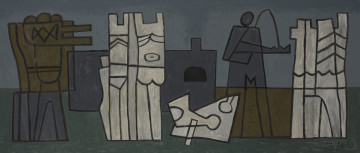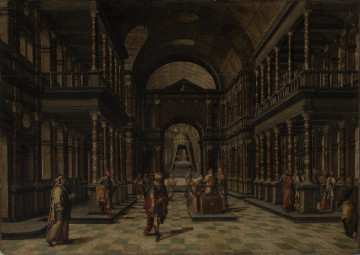
untitled
między 1958 — 1965
National Museum in Szczecin
Part of the collection: European classics of modernity
The work of Stanisław Ignacy Witkiewicz (who adopted the pseudonym Witkacy in 1913) is among the most recognizable in the popular circulation of Polish art from the first half of the 20th century. As the son of the renowned painter, architect, and art theorist Stanisław Witkiewicz Sr., he was immersed from an early age in a circle of distinguished artists and scholars of the older generation. His admission to the Academy of Fine Arts in Kraków further introduced him to young avant-garde creators.
The aesthetics of ugliness, employed in literature by Roman Jaworski, led Witkacy to begin drawing charcoal “monsters.” His acquaintance with Karol Beaurain, a pioneer of psychoanalysis in Poland, and the therapy he underwent in 1912 introduced him to Sigmund Freud’s methods, while his friendship with the philosopher, economist, and internationally renowned anthropologist Bronisław Malinowski opened him up to inspirations from non-European cultures. In 1914, the first year of the war, in which the drawing from the Szczecin collection was created, Witkacy’s fiancée, Jadwiga Janczewska, suspected of infidelity, committed suicide. This deepened his depressive state and his catastrophic visions. Suicidal thoughts and sexual obsessions were meant to be dispelled by an ethnographic expedition to New Guinea, suggested by Malinowski, which the friends embarked on that summer. The unconventional compositions drawn during this time reflect Witkacy’s personal turmoil, as well as his artistic restlessness, which ultimately led to the crystallization of his own theory of “Pure Form.”
The deathbed scene, featuring a gaunt bearded man, an old woman, a doctor, a priest, and a departing couple, simultaneously portrays the erotic temptation of the dying man by a young woman. The ambiguity of the scene is heightened by an almost landscape-like study of the draped fabric, shaped through a trembling, undulating contour and strong hatching, reminiscent of the geological-cosmic fantasies of some German and Austrian Expressionists. Initially, these artists welcomed the outbreak of war as the advent of long-awaited political and social changes. Witkacy also sought to contribute to these transformations; however, contrary to his father’s pro-Austrian views, he aligned himself with the Russian side.
Szymon Piotr Kubiak
Author / creator
Object type
drawing
Technique
coal
Material
ribber paper
Origin / acquisition method
purchase
Creation time / dating
Creation / finding place
Owner
The National Museum in Szczecin
Identification number
Location / status

między 1958 — 1965
National Museum in Szczecin

1600 — 1625
National Museum in Szczecin

1814
National Museum in Szczecin
DISCOVER this TOPIC
Castle Museum in Łańcut
DISCOVER this PATH
Educational path